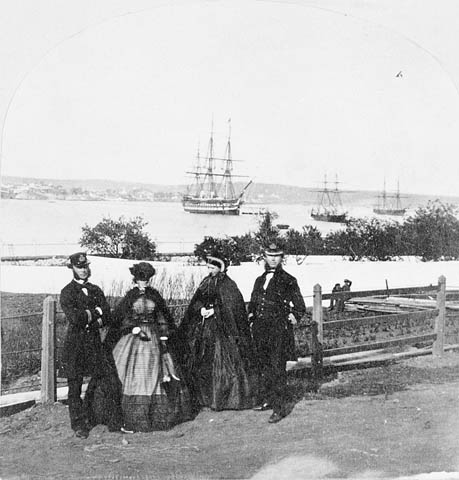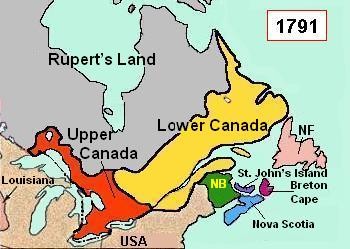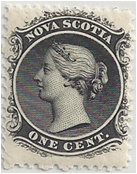ALBUM – view my Nova Scotia album
TRANSITION CHART – Canada Area
Fast Facts
Region: North America / Hawaii
Group: Canadian States
Classification: Colony (UK)
Prior Regime: French Colony
Key Dates:
1713 – Nova Scotia became British colony, treaty of Utrecht gave Nova Scotia to British
1763 – Cape Breton Island, New Brunswick, St. John’s Island (now Prince Edward Island) becomes a part of Nova Scotia from the French
1769 – Prince Edward Island established as independent colony
1784 – Cape Breton Island, New Brunswick became independent colonies
1820 – Cape Breton Island rejoined Nova Scotia
1849 – Nova Scotia becomes the first colony in British North America to become self-governing within the British Empire
1867 – Nova Scotia joins New Brunswick and Canada Province to form the Dominion of Canada
Following Regime: Dominion of Canada (British Colony)
Scott Catalogue: (Nova Scotia) #1-28
Pick Catalogue: none
History

Over the next 50 years, the French and British continued to battle over the region in the King George’s War in 1744 and the French and Indian War (1754-1763). In 1784, New Brunswick (due to intense lobbying from the Loyalists) and Cape Breton Island became independent colonies of the British Empire. Cape Breton Island rejoined Nova Scotia in 1820.
 As a result of the American Revolution (1775-1783), about 30,000 British Loyalists migrated to southwestern Nova Scotia (New Brunswick). In 1784, New Brunswick, along with Cape Breton Island became independent colonies of the British Empire. Cape Breton Island rejoined Nova Scotia in 1820.
As a result of the American Revolution (1775-1783), about 30,000 British Loyalists migrated to southwestern Nova Scotia (New Brunswick). In 1784, New Brunswick, along with Cape Breton Island became independent colonies of the British Empire. Cape Breton Island rejoined Nova Scotia in 1820.
The movement to unify Canada begn taking shape in the early 1860s, and on July 1st, 1867, Nova Scotia joined New Brunswick and Canada Province to form the Dominion of Canada
Stamps
 ALBUM
ALBUM
The first adhesive postage stamps of Nova Scotia were issued on Sept 1st, 1851. The stamps were diamond shaped and depicted the Crown of Great Britain, surrounded by Heraldic Flowers of the Empire. The design was very similar to the stamps issued by the neighboring colony, New Brunswick. The issues consisted of three denominations: 3p blue, 6p yellow green and 1sh dull violet. In 1853, a 1p stamp was issued featuring the portrait of Queen Victoria, on a similar design, but square. In 1857, the three diamond stamps were reissued, but in distinctly different shades of the same color. Beginning in 1854, bisecting Nova Scotia stamps were allowed, especially to accommodate a new 7-1/2 pence rate to England.
On Jan 1st, 1860 Nova Scotia switched to a decimal currency, using dollars and cents and in Oct, 1860, stamps were issued in Nova Scotia to accommodate the new currency. Five different denominations, 1c, 5c, 8-1/2c, 10c and 12-1/2c were printed on two different portrait designs of Queen Victoria, one profile and one full face. In May, 1863, an additional 2c value was printed to accommodate a new local postal rate. Minor varieties exist, and the most common to collect are stamps on white paper, and toned paper. Horizontal pairs, not perforated between are also known.
The stampf of Nova Scotia were gradually replaced by the stamps of Canada after Nova Scotia became part of the Confederation on July 1, 1867. With the exception of the 5c denomination, remainders of unused Nova Scotia stamps were sold by the government to collectors, in February of 1895. One fun fact: the 1863 Kingdom of Hawaii 2c stamp featuring King Kamehameha IV, was designed after the 10c, 1860 Nova Scotia stamp.
Banknotes
In 1812, the Provincial Government introduced Treasury notes in denominations of 1, 2½, 5 and 50 pounds. Between 1813 and 1830, notes for 1, 2 and 5 pounds were issued. 5 and 10 shilling notes were added in 1830. Along with the Treasury notes, two chartered banks issued paper money in Nova Scotia, the Bank of Nova Scotia, and the Halifax Banking Company. The Halifax Banking Company issued notes from 1825, in denominations of 1½, 5, 6, 6½ and 7 pounds, whilst the Bank of Nova Scotia began issuing notes in 1834, with denominations of 1½, 2, 2½, 5, ¼, 6, 7, 7½ and 10 pounds.
Between 1861 and 1866, the Provincial Government introduced Treasury notes for 5 dollars. In addition, three chartered banks issued paper money in Nova Scotia, the Bank of Nova Scotia, the Halifax Banking Company and the Merchants Bank of Halifax. The private banks all issued notes in a single denomination, 20 dollars. They later issued notes in Canadian dollars. The Province of Canada issued notes dated 1866 overprinted with “Payable in Halifax / only”. These were for circulation in Nova Scotia as local currency.
Links
History of Nova Scotia from Wikipedia
Nova Scotia from Stamp Collecting World
History of the Atlantic Colonies
Nova Scotia Stamp Club
Canadian Chartered Banks at Wikipedia





Michael
Great write-up on Nova Scotia.
And your virtual albums are a real treat. I must say, the album looks real to me. 😉
I might cover more countries; but for the Dead Ones, you are the Gold standard!
Jim
Jim,
Thanks for the nice note. I look forward to seeing what you do when you get to Nova Scotia at Big Blue.
Michael